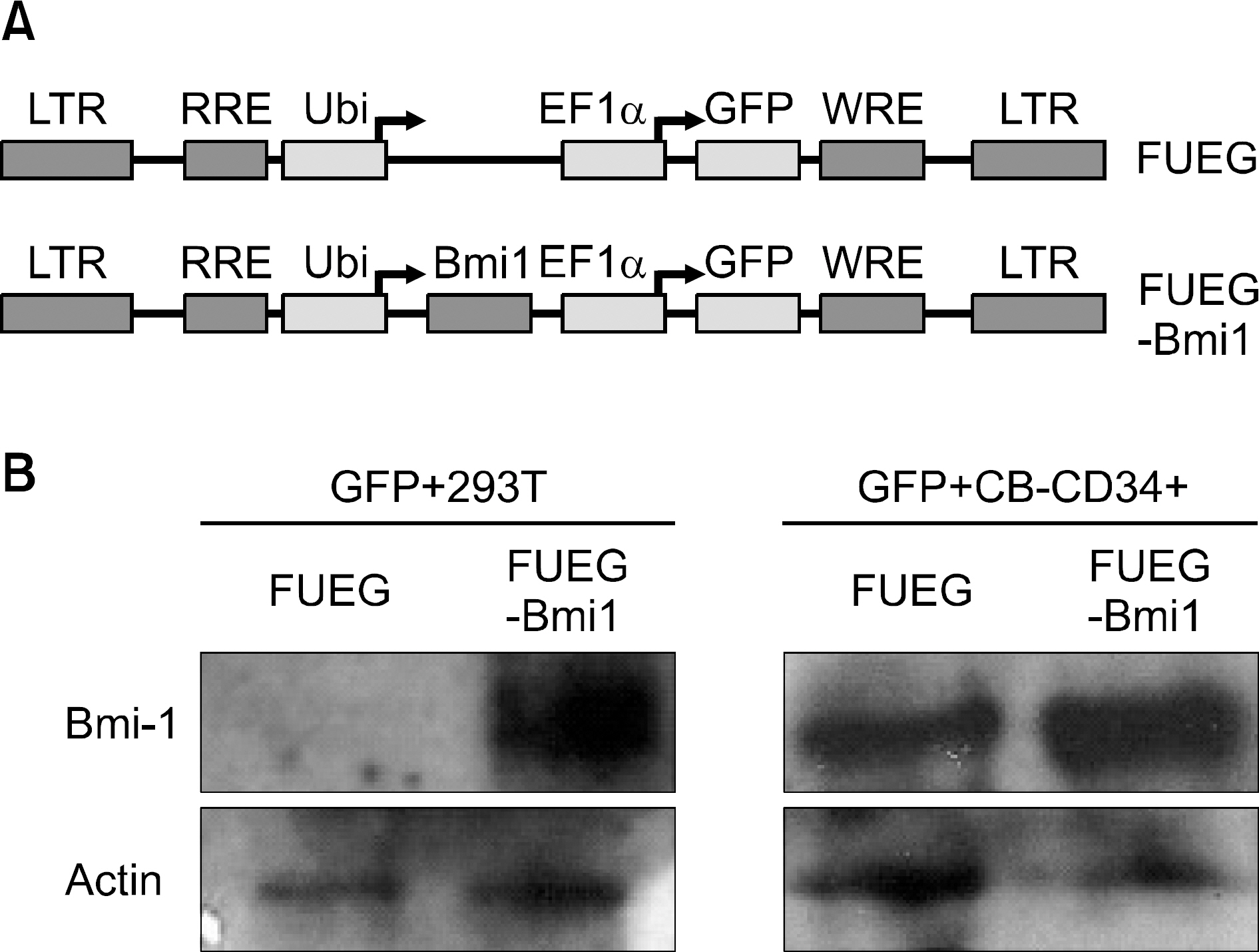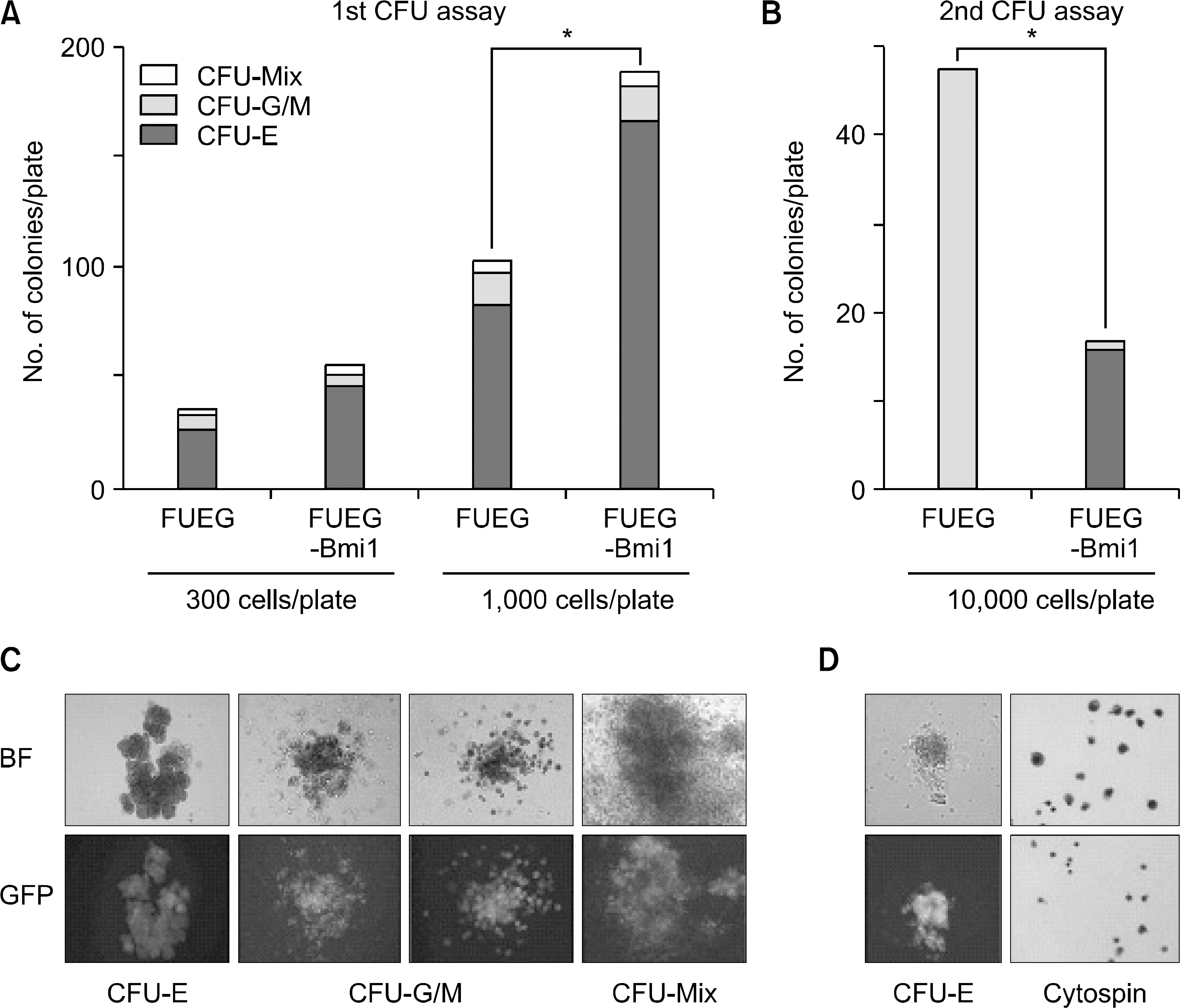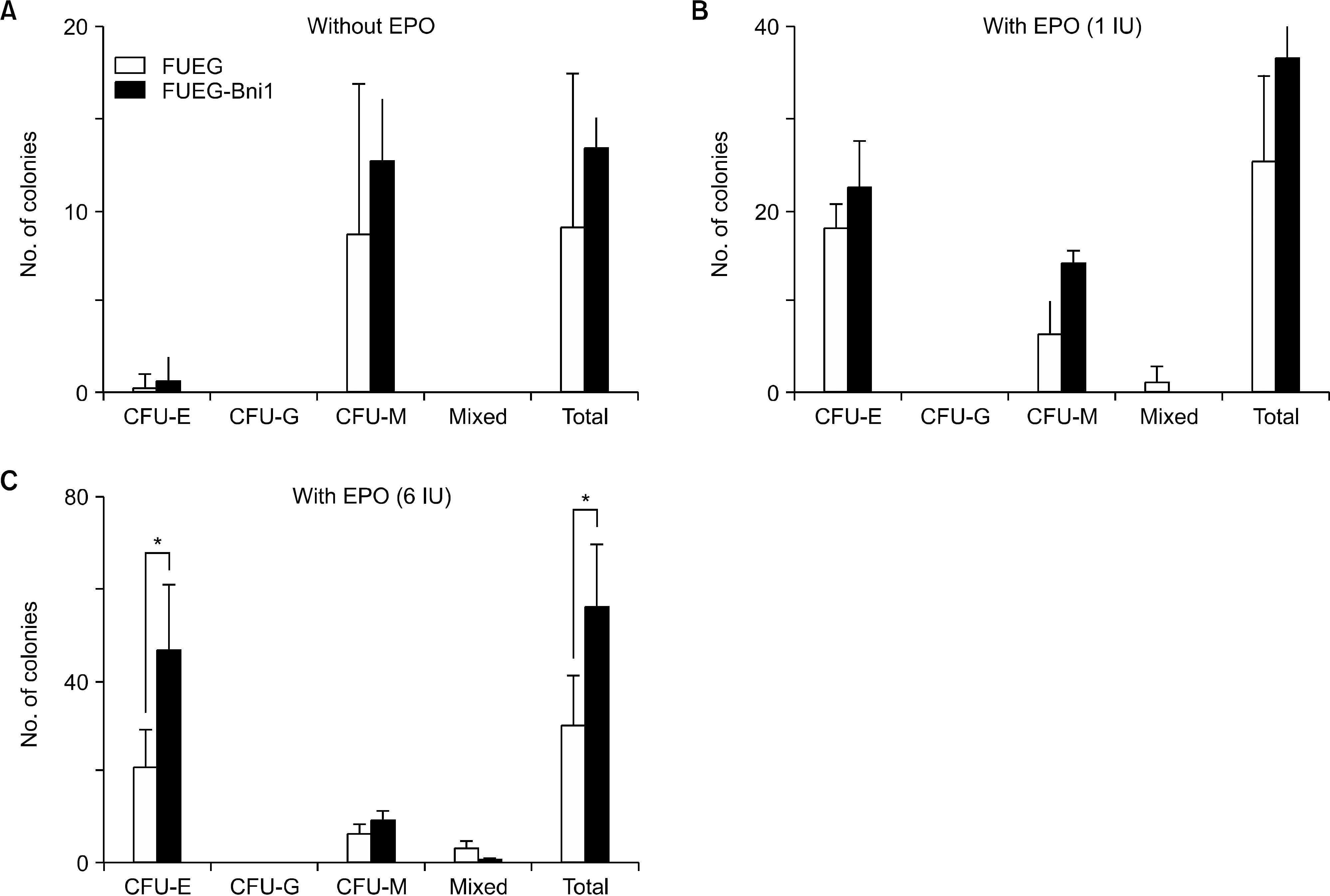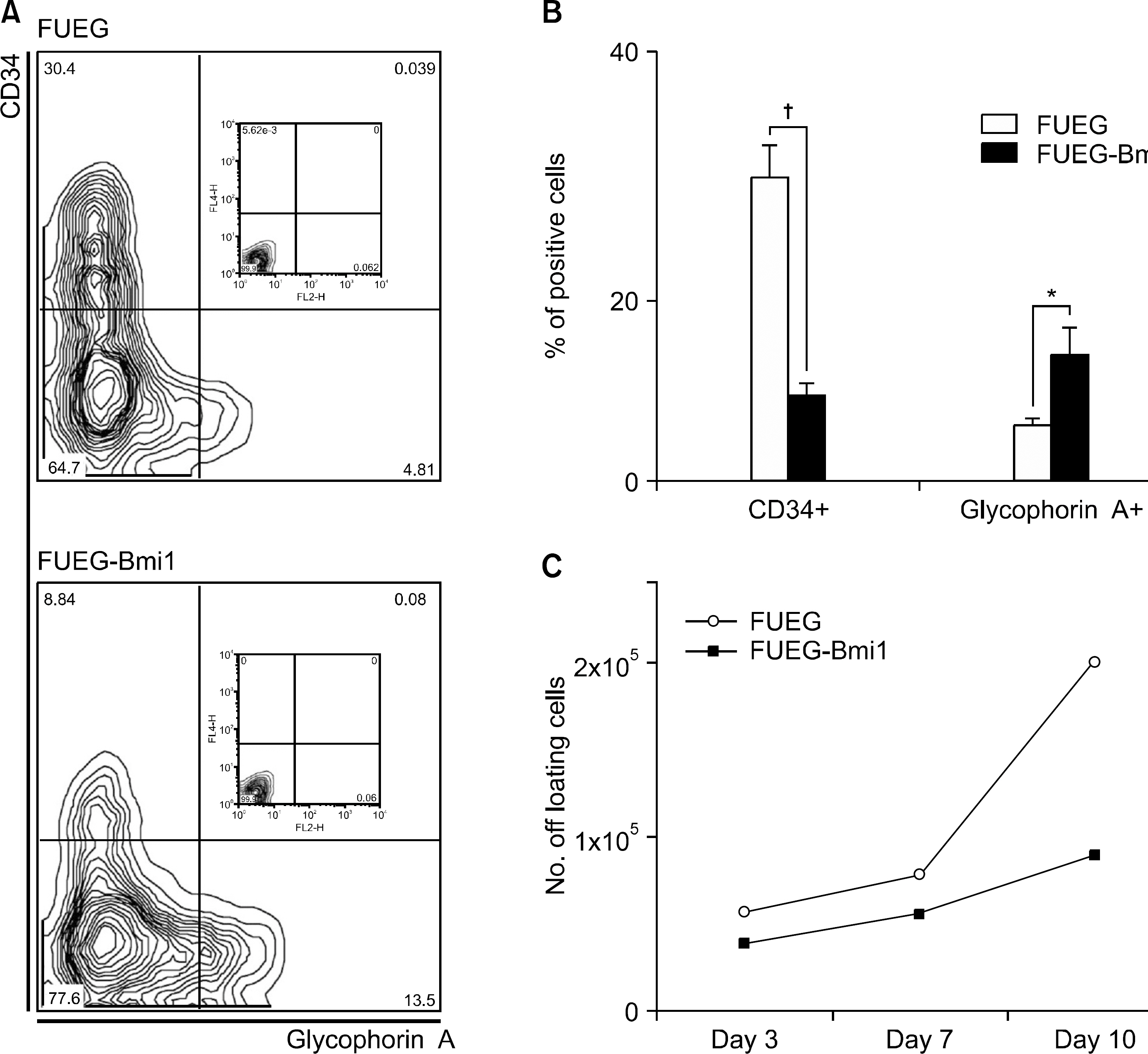Korean J Hematol.
2007 Sep;42(3):241-249. 10.5045/kjh.2007.42.3.241.
Enforced Expression of BMI-1 in Postnatal Human CD34+ Cells Promotes Erythroid Differentiation
- Affiliations
-
- 1Craniomaxillofacial Life Science 21, College of Dentistry, Seoul National University, Korea. gabsang@gmail.com
- 2Division of Hematology/Oncology, Korea University Medical Center, Seoul, Korea.
- 3Cell Biology Program, Memorial Sloan Kettering Cancer Center, Korea.
- KMID: 2305199
- DOI: http://doi.org/10.5045/kjh.2007.42.3.241
Abstract
-
BACKGROUND: The Polycomb-group gene Bmi-1 is known to be a molecular regulator of self-renewal of normal and leukemic stem cells and be involved in various aspects of cellular proliferation, differentiation, and survival.
METHODS
This study evaluated the effects of overexpression of Bmi-1 on human cord blood CD34+ cells. Bmi-1 was introduced into CD34+ cells through lentivirus transduction. Bmi-1 expressing CD34+ cells were applied to colony forming assay, stromal co-culture, and cytokine-stimulatied culture.
RESULTS
Ectopic expression of Bmi-1 resulted in the increased number of erythroid colonies in primary and secondary colony forming assay in an erythropoietin dependent manner. In stromal co-culture, Bmi-1-expressing postnatal hematopoietic stem cells seemed to lose the ability of self-renewal, as determined by week 5 cobblestone area-forming cell assay and by week 5 secondary colony assay. In cytokine-stimulated suspension culture of Bmi-1-transduced CD34+ cells, we observed increased erythropoiesis marked by Glycophorin A expression.
CONCLUSION
Our data suggest that ectopic expression of Bmi-1 in human hematopoietic stem/progenitor cells may result in the differentiation to the erythroid lineage rather than promoting self-renewal.
Keyword
MeSH Terms
Figure
Reference
-
1). Lund AH., van Lohuizen M. Polycomb complexes and silencing mechanisms. Curr Opin Cell Biol. 2004. 16:239–46.
Article2). Buszczak M., Spradling AC. Searching chromatin for stem cell identity. Cell. 2006. 125:233–6.
Article3). Molofsky AV., He S., Bydon M., Morrison SJ., Pardal R. Bmi-1 promotes neural stem cell self-renewal and neural development but not mouse growth and survival by repressing the p16Ink4a and p19Arf senescence pathways. Genes Dev. 2005. 19:1432–7.
Article4). Molofsky AV., Pardal R., Iwashita T., Park IK., Clarke MF., Morrison SJ. Bmi-1 dependence distinguishes neural stem cell self-renewal from progenitor proliferation. Nature. 2003. 425:962–7.
Article5). Christopher FA., Dimos JT., Ivanova NB., Lowry N., Lemischka IR., Temple S. shRNA Knockdown of Bmi-1 Reveals a Critical Role for p21-Rb Pathway in NSC Self-Renewal during Development. Cell Stem Cell. 2007. 1:12.
Article6). Park IK., Qian D., Kiel M, et al. Bmi-1 is required for maintenance of adult self-renewing haematopoietic stem cells. Nature. 2003. 423:302–5.
Article7). Iwama A., Oguro H., Negishi M, et al. Enhanced self-renewal of hematopoietic stem cells mediated by the polycomb gene product Bmi-1. Immunity. 2004. 21:843–51.
Article8). Lessard J., Sauvageau G. Bmi-1 determines the proliferative capacity of normal and leukaemic stem cells. Nature. 2003. 423:255–60.
Article9). Lessard J., Baban S., Sauvageau G. Stage-specific expression of polycomb group genes in human bone marrow cells. Blood. 1998. 91:1216–24.
Article10). Hemmati HD., Nakano I., Lazareff JA, et al. Cancerous stem cells can arise from pediatric brain tumors. Proc Natl Acad Sci USA. 2003. 100:15178–83.
Article11). Mihic-Probst D., Kuster A., Kilgus S, et al. Consistent expression of the stem cell renewal factor BMI-1 in primary and metastatic melanoma. Int J Cancer. 2007. 121:1764–70.
Article12). Glinsky GV., Berezovska O., Glinskii AB. Microarray analysis identifies a death-from-cancer signature predicting therapy failure in patients with multiple types of cancer. J Clin Invest. 2005. 115:1503–21.
Article13). Jacobs JJ., Kieboom K., Marino S., DePinho RA., van Lohuizen M. The oncogene and Polycomb-group gene bmi-1 regulates cell proliferation and senescence through the ink4a locus. Nature. 1999. 397:164–8.
Article14). Jacobs JJ., Scheijen B., Voncken JW., Kieboom K., Berns A., van Lohuizen M. Bmi-1 collaborates with c-Myc in tumorigenesis by inhibiting c-Myc-induced apoptosis via INK4a/ARF. Genes Dev. 1999. 13:2678–90.
Article15). Zhang P., Iwasaki-Arai J., Iwasaki H, et al. Enhancement of hematopoietic stem cell repopulating capacity and self-renewal in the absence of the transcription factor C/EBP alpha. Immunity. 2004. 21:853–63.16). Oneal PA., Gantt NM., Schwartz JD, et al. Fetal hemoglobin silencing in humans. Blood. 2006. 108:2081–6.
Article17). Weinberg RA. The retinoblastoma protein and cell cycle control. Cell. 1995. 81:323–30.
Article18). Walkley CR., Shea JM., Sims NA., Purton LE., Orkin SH. Rb regulates interactions between hematopoietic stem cells and their bone marrow micro-environment. Cell. 2007. 129:1081–95.
- Full Text Links
- Actions
-
Cited
- CITED
-
- Close
- Share
- Similar articles
-
- Differentiation and Apoptosis of the Erythroid, Myeloid and Megakaryocytic Lineage Cells in vitro Culture of Cord Blood CD34+ Cells Using Various Cytokines
- Proliferation and Differentiation of Erythroid Progenitors from Cord Blood CD34 (+) Cells Using Extracellular Matrix and Stromal Cells
- Comparative Evaluation for Potential Differentiation of Endothelial Progenitor Cells and Mesenchymal Stem Cells into Endothelial-Like Cells
- Comparison of CD34+ subsets and clonogenicity in human bone marrow, granulocyte colony-stimulating factor-mobilized peripheral blood, and cord blood
- Role of Ras/ERK-dependent pathway in the erythroid differentiation of K562 cells






